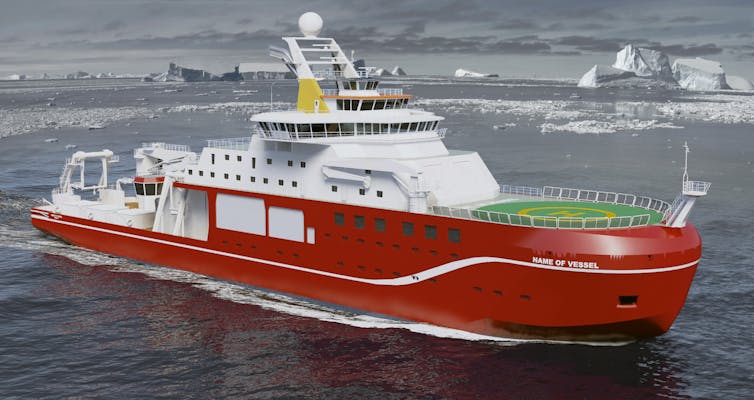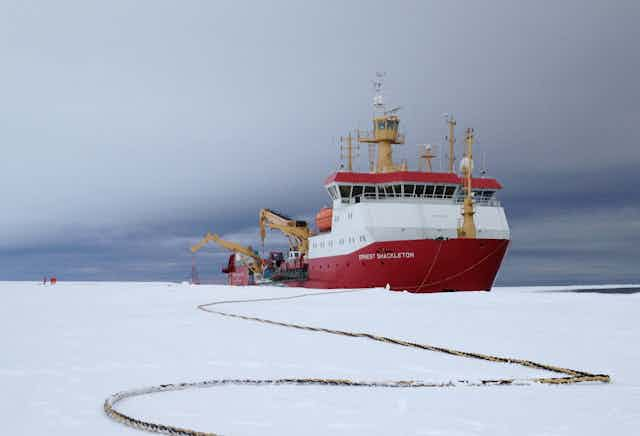Thanks to the wonders of online democracy, Britain’s new £200m scientific research ship could well set sail with the distinctive name: “Boaty McBoatface”. The decision by the UK’s Natural Environment Research Council (NERC) to submit the choice of a name for the ship to a public online vote has led to unprecedented publicity – and an unexpected front runner.
In a statement NERC said that the RRS Boaty McBoatface, if it is indeed given that name, would: “help put the UK at the forefront of ocean research for years to come”.
Whether investigating the water column or exploring the earth beneath the sea, research ships around the world essentially help answer big scientific questions about our planet that we simply couldn’t have done by staying on dry land.
The UK’s fleet, including the RRS (Royal Research Ship) James Cook and RRS James Clark Ross, can be used to investigate the water itself or the life in it. Scientists on these ships can also remotely measure the seafloor using ship-mounted, towed or autonomous instruments which can help visualise things in high-resolution. They can also grab samples from the seabed itself or use coring devices to sample depths of up to 55 metres using systems such as the British Geological Survey’s RockDrill 2 (RD2).

The UK remains a leader in the fields of oceanography and marine geology and geophysics and the new NERC polar research vessel, scheduled to come online in autumn 2019, should help sustain that position.
Other, larger, research ships are primarily tasked with drilling, sampling and measuring what lies below the seabed in much the way the oil and gas industry does. These include the three ships run by the long-standing International Ocean Discovery Program(IODP), an international consortium of 26 countries including the UK.
The IODP’s fleet is used to help answer questions related to climate and sea-level change, the origins of life, and geohazards, including tsunamis, earthquakes and landslides. IODP also hosts more “blue-sky” projects, for example an expedition scheduled to start this April will drill and sample the crater from a meteorite impact that is alleged to have led to the demise of the dinosaurs.
Life at sea
Participating in a research cruise is the equivalent of fieldwork for marine scientists, with hard hats, life jackets and steel toe-capped boots in place of rock hammers and hiking boots. Scientists are typically expected to work a shift pattern which will vary depending on the sort of work being done, but could be 12 hours on and 12 hours off. This pattern is worked seven days a week for the duration of the project which may range from a week to a few months.

A typical day is punctuated by meal times (every six hours or so) and “smoko”, a short break similar to a coffee break, with the remainder of on-shift time taken up by work in laboratories, on deck or behind a computer. Off-shift time allows scientists to relax and use the ship’s facilities which may include a gym, a library, a TV lounge and a sauna (though I am yet to encounter a masseuse, which is where Wes Anderson’s The Life Aquatic strays somewhat from the truth).
Want to set sail on RSS Boaty McBoatface? The recruitment of scientists on research cruises depends on the ship and the project. For NERC ships, projects are usually proposed by a member of the scientific community and it is typically down to the principal investigator of a project to recruit scientists to staff the project. Other programmes, including the IODP, have a more open and formalised system for recruitment, with calls for applications to sail going out on a regular basis.
We know ice is melting at either end of the world. Research is critical to help us understand what this means for the climate, sea levels, ocean circulation and for our ecosystems. The new vessel will be able to stay out at sea for longer than the UK’s existing research ships, and will be better at breaking and travelling through polar sea ice.

It will also have advanced communication and data handling systems, as well as the capability to deploy new generation robotic autonomous and remotely-operated vehicles. A hole in the ship, known as a moon-pool, will allow easy sea access for large instruments or even a drilling rig.
As with most other research ships, multidisciplinary international collaborative science will be at the new polar vessel’s core, with the remit of providing timely answers to high level climate and ocean research questions.
So, what do we name such a versatile and technologically advanced ship which holds so much promise? My own vote went to RRS FitzRoy, after the captain of Charles Darwin’s HMS Beagle and father of the shipping forecast, but Boaty McBoatface certainly has the world’s attention.

